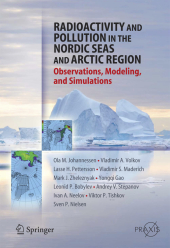 Neuerscheinungen 2014Stand: 2020-02-01 |
Schnellsuche
ISBN/Stichwort/Autor
|
Herderstra▀e 10
10625 Berlin
Tel.: 030 315 714 16
Fax 030 315 714 14
info@buchspektrum.de |

Leonid P. Bobylev, Yongqi Gao, Olaf M. Johannessen, Vladimir S. Maderich, Ivan A. Neelov, Lasse H. Pettersson, Andrey V. Stepanov, Vladimir A. Volkov, Mark J. Zheleznyak
(Beteiligte)
Radioactivity and Pollution in the Nordic Seas and Arctic
Observations, Modeling and Simulations
By Johannessen, Olaf M.; Volkov, Vladimir A.; Pettersson, Lasse H.; Maderich, Vladimir S.; Zheleznyak, Mark J.; Gao, Yongqi; Bobylev, Leonid P.; St
2014. xxxvi, 408 S. 138 SW-Abb.,. 242 mm
Verlag/Jahr: SPRINGER, BERLIN 2014
ISBN: 3-642-26273-2 (3642262732)
Neue ISBN: 978-3-642-26273-9 (9783642262739)
Preis und Lieferzeit: Bitte klicken
This book describes a new tool called the Generic Model System for simulations and assessment of potential radioactive spreading in the Arctic regions. It considers the present and future potential for spreading of radionuclear pollution from sources such as from the major Russian processing plants as well as from European sources such as the UK Sellafield plant. The book combines the expertise of professionals from the radionuclear and climate-change sciences.
1 Sources of anthropogenic pollution in the Nordic Seas and Arctic 1.1 Radioactive contamination: classification and description of sources 1.1.1 Classification of sources 1.1.2 Nuclear power plants 1.1.3 Nuclear industry enterprises 1.1.4 Scientific and research reactors and laboratories 1.1.5 Special combines 1.1.6 Nuclear weapons tests and ┤peaceful┤ nuclear explosions 1.1.7 Military bases, nuclear icebreakers and submarines 1.2 Radioactive pollution: major Russian nuclear industries 1.2.1 Mayak Production Association, Chelyabinsk 1.2.2 Siberian Chemical Combine, Tomsk-7 1.2.3 Mining and Chemical Combine, Krasnoyarsk-26 1.3 Non-radioactive pollution 1.3.1 Main sources of the pollution in the Russian Arctic marine environment 1.3.2 Pollution in the Russian Arctic Seas and coastal areas 2 Study region and environmental datasets 2.1 Geographical description of the region of study 2.1.1 The Ob┤ and Yenisei river basins 2.1.2 Kara Sea region 2.1.3 The Nordic Seas and adjacent seas 2.2 Description of environmental data used in this study 2.2.1 Environmental data 2.2.2 Radioactive pollution data 2.2.3 Other non-radioactive pollution data 3 Generic model system (GMS) for simulation of radioactive spreading in the aquatic environment 3.1 Rationale, concept and structure of the GMS 3.1.1 GMS structure and data streams 3.1.2 Modelling management 3.2 Atlantic and Arctic Ocean model 3.2.1 General model description 3.2.2. Radionuclide tracer module 3.2.3 Model validation results 3.3 Kara Sea shelf sea model 3.3.1 General model description 3.3.2 Model validation results 3.4 The Ob and Yenesei River and estuary models 3.4.1 One-dimensionalmodel for the simulation of the transport of radionuclides in the river system - RIVTOX 3.4.2 Numerical model for three-dimensional dispersion simulation of radionuclides in stratified water bodies - THREETOX 3.4.3 River model validation results 4 Studies of the potential radioactive spreading in the Nordic Seas and Arctic using the generic model system (GMS) 4.1 Simulation of past contamination of the Nordic Seas and Arctic from anthropogenic releases 4.1.1 River and estuary transport and dilution of radioactive pollutants from rivers to the Kara Sea 4.1.2 Transport and dilution of radioactive waste and dissolved pollutants in the Kara Sea 4.1.3 Transport and dilution of radioactive waste and dissolved pollutants from all sources 4.2 Scenarios for potential future releases of radioactivity 4.2.1 ┤Mayak┤ scenario 4.2.2 ┤Krasnoyarsk┤ scenario 4.2.3 ┤Tomsk┤ scenario 4.2.4 ┤CO2 doubling┤ scenario 4.2.5 ┤Submarine┤ scenarios 4.3 Assessments of potential accidental releases for the 21st century 4.3.1 Potential radioactive contamination from the rivers to the Kara Sea 4.3.2 Potential radioactive contamination in the Kara Sea 4.4 Transport of radioactivity in the Arctic and possible impact of climate change 4.4.1 Accident scenario of 90-Sr from the Ob┤ and Yenisei Rivers 4.4.2 Spreading of accidentally released 90-Sr under present and 2 CO2 warming scenario 4.5 Potential transport of radioactivity from submarine accidents 5 Studies of non-radioactive pollutant spreading in the Arctic using the generic model system (GMS) 5.1 Approach to simulation of pollutants in the aquatic environment 5.1.1 Persistent Organic Pollutants 5.1.2 Basic processes and equations for modelling 5.1.3 Modelling POP transport in the environment 5.2 Modelling PCB


